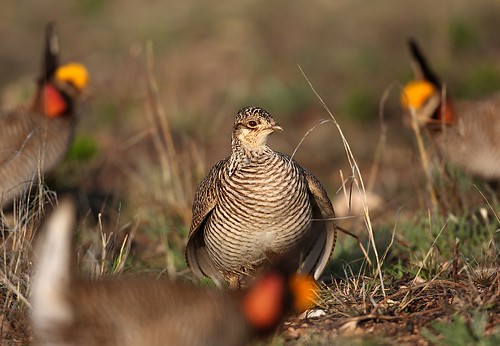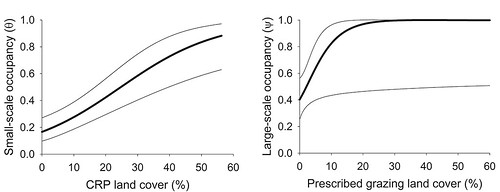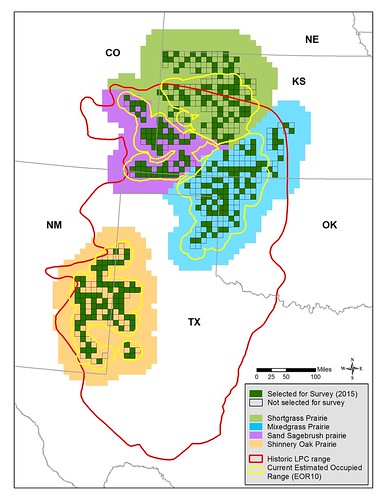
Lesser prairie-chickens benefit from lands where a rancher is using prescribed grazing, according to a new report. Photo courtesy of Nick Richter.
Habitat conservation practices make a difference for lesser prairie-chickens. That’s the finding of a recent scientific study – the first part of a multi-year study – described in a new report from the Lesser Prairie-Chicken Initiative (LPCI).
LPCI, led by USDA’s Natural Resources Conservation Service (NRCS), works with partner organizations and ranchers to improve habitat and address threats to the bird. Since 2010, more than 1 million acres of habitat have been restored on working lands.
NRCS works with partners to monitor the outcomes, which helps determine if conservation practices are making a difference, but accurately estimating wildlife populations can be challenging with uncommon, widely dispersed species like the lesser prairie-chicken.
A recent study identified a new model for assessing lesser prairie-chicken populations, and it shows encouraging evidence that NRCS-recommended conservation practices through LPCI are working and that large blocks of intact prairie are important to prairie-chicken conservation.
The study assessed one year of data from the annual aerial survey of lesser prairie-chicken lek sites conducted by the Western Association of Fish and Wildlife Agencies, and it looked at four factors that might impact site occupancy — patch size of native vegetation, percent of land cover managed with prescribed grazing; percent of land cover enrolled in USDA’s Conservation Reserve Program (CRP); and density of primary roads. The research team intends to continue with a multi-year study that assesses additional variables.

As the amount of land enrolled in CRP or using prescribed grazing increases, the likelihood that lesser prairie-chickens will occupy that land also increases.
Lesser prairie-chickens face many threats, including habitat loss and fragmentation from row-crop agriculture, fire suppression, unmanaged grazing, development, and drought. The species currently occupies just 16 percent of its historic range.
But in western Kansas, lesser prairie-chickens have reoccupied portions of their historical range and have even moved into areas outside that historical range. The range expansion coincides with former croplands enrolled and maintained as grasslands through CRP as well as native grasslands managed using LPCI prescribed grazing practices.
A team of researchers tested whether there was a quantifiable link between land where ranchers are implementing LPCI prescribed grazing plans or have enrolled their land in CRP and the likelihood of prairie-chickens occupying a landscape. Their results indicate that these habitat conservation efforts are working.
After developing an expanded model for assessing lesser prairie-chicken populations, the team found that occupancy increases as prairie patch-size increases, as well as in landscapes with ongoing conservation practices. Specifically, the results indicate that when ranchers are using prescribed grazing or enrolling land in CRP, the likelihood of lesser prairie-chickens occupying that habitat increases significantly.
The report’s management recommendations include:
- Enrolling acreage within the lesser prairie-chicken active range in prescribed grazing or CRP.
- Maintaining large blocks of native prairie across the range through sustainable ranching.
- Identifying potential landscapes with willing landowners to develop conservation easements, particularly if combined with prescribed grazing and other proven habitat conservation practices.
- Implementing prescribed grazing on dispersed patches throughout large blocks of rangeland.
- Cultivating diverse stands of CRP-enrolled grasslands that serve as connective tissue to larger patches of native prairie.
- Retaining CRP acreage as grasslands after contract expiration.
NRCS outlined its three-year conservation strategy for lesser prairie-chicken conservation, which encourages adoption of many of the above recommendations on 500,000 additional acres, such as prescribed grazing, using easements to protect key habitat corridors, and providing assistance to convert expiring CRP lands to grazing.
Learn more about these findings by downloading this new report. This report is part of the Science to Solutions series offered through NRCS, LPCI and the Sage Grouse Initiative.

Map of current and historical range of the lesser prairie-chicken, showing sites surveyed during the 2015 range-wide aerial survey. The data from this survey was used to assess the occupancy of lesser prairie-chickens.
No comments:
Post a Comment
Note: Only a member of this blog may post a comment.